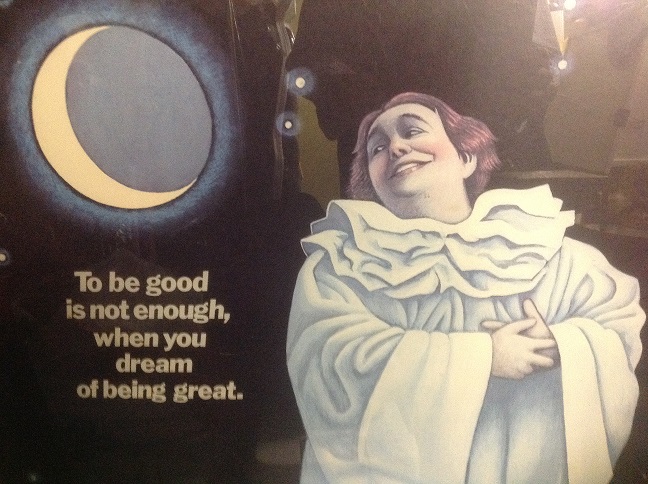What Drives Vision [a survey]
March 20, 2015
Protecting the Empire
March 22, 2015THE POWER OF A CLEAR VISION
What is Vision? – How do you create a Vision? – How do you transfer a Vision to others?
Webster’s Ninth New Collegiate Dictionary defines Vision as:
The act or power of imagination;
Something seen as a dream, trance or ecstasy;
Mode of seeing or conceiving.
In the mid 1980’s, I was given the chance to be the Director of Training and Communications for the regional department store The Bon Marche. This was a wonderful experience that gave me the challenge of changing the service culture for over 5,000 employees. Part of the challenge of this effort was to take a large group of employees and engage them in owning a new standard of behaviors that were in many ways totally different from the behaviors practiced in the history of the operation.
In researching different ways of trying to accomplish this effort, I was encouraged to attend several seminars that dealt with concepts of how to change people’s behaviors and attitudes. The seminar that dealt most with Vision was presented by Lou Tice and the Pacific Institute. I completed the 5 day seminar and received my certificate as an official Pacific Institute facilitator, which allowed me to purchase the program materials and facilitate the presentation of these materials to the Bon Marche’s employees. The basic message of this program had been given to the Nordstrom’s employees and Nordstrom was now leading the nation in selling customer service as a core business factor – and the Pacific Institute materials were considered the gold standard in enabling the Nordstrom’s employees to embrace this level of behavior.
What I discovered was not that the Program sold a service concept – No, the Institute’s program was built around the concept that until you can see what you want, it is impossible for you to get it. IF YOU CAN’T SEE IT, YOU CAN’T GET IT!! What an interesting concept – once you are looking to buy a brick home, all you see are brick homes – until you decide you want a deck on your house, you don’t see lumberyards – and until you see yourself as a great sales associate, you can’t be a great sale associate.
So, the great driver of any organization is not that is has a great vision, it is that the great vision is owned by the individuals who need to see the vision, in order for the organization to accomplish that vision. So here is the dilemma: vision is intuitive and inspirational, and the majority of people are tangible – they see things as they are, not as they might be. Being visionary is great, but transferring a vision to others represents brilliance. In Functional Management, there are three distinctive parts to a management system: Crisis Management, Operational Management, and Initiative Management. To think that one vision works for all of these management needs is wrong. In many ways you need to define a vision for each of these management functions.
Let’s start with Crisis Management – if you have read my other posts you will find that I don’t believe that managing a crisis is a vision unto itself. The vision for a crisis is that people do not panic and they all have an image/idea of how it will be handled. This concept of how to handle a crisis is that the crisis is the exception to the rule, not the rule itself. (I do believe that there is a group of managers that find a crisis in almost everything they do. If you are working in an organization where senior leadership needs a lot of control, there is a chance that there will be more crisis than needed – just as a way to allow the senior management to have a sense of greater control.)
In a true crisis everyone should know what to do, and that requires the foresight to envision what should happen. Operational Management vision sometimes looks more like a series of objectives connected together. In my view, the operational vision is more associated to the organizational culture and should support the organization’s brand. So, I have now introduced the concept that Vision, Culture, and Brand are all associated to each other. The relationship of these three concepts becomes very intuitive and inspirational – but they all are interrelated, and each of these elements has to be connected for the organization to maximize its human capital. There are many tools that support this vision area: Job descriptions, Performance standards, Employee surveys, Dash boards, Reward programs, and Employee reviews, to name just a few. This is best summed up in the statement: “This is how we do things”.
In Initiative Management –vision is everything. As I have discussed in other posts The Concept of Change and Finding Creative Solutions, no matter where your organization is in its life cycle, you will have to change what you are doing or you will have to change how you are doing it – the speed at which change is happening is mind-altering. There is a chance that you don’t actually have a clear vision or picture of where you need to go – so then the process and analysis of developing brand culture helps to clarify vision and build ownership.. The core issue is still the ability for everyone in the organization to share ownership and clear understanding of the Process of What is going to change, Why this change/initiative is necessary, and How this process will get us there.
The language of this vision area is: * Initiatives * Cultural change * Business development * Aspiration – and all of these concepts are leveraged with organizational risk and reward. Though the vision offers a picture of success, the outcome is up to the execution, and the employees’ responsiveness and effort to get there. If the employees do not see and understand the picture of success or the Process that is happening, you will fail. IF YOU CAN’T SEE IT, YOU CAN’T GET IT!!
So how do you transfer ownership of a vision?
My answer to this question is very old school. I think organizations’ leadership have lost the power of the old school approach to managing their cultures. After the last 9 years of financial stress, the response of leadership has primarily been to downsize below the level of logical employee needs, focus on quarterly profits at the expense of long term vision, and, in some cases, focus on just plain greed. We have lost the time required to ensure that organizational vision in all three areas of operations can be communicated and supported. The organizational infrastructure has been neglected, and the possible ramifications are serious and sad. Having said that, I believe that re-invigorating the basic old school approach does not require excessive time, or money, it simply requires seeing how, if done in alignment –the outcome will be very rewarding.
In basic communications training there are 2 sides to any communications: the sending of a message and the receiving of the message. It is the sender’s responsibility to send a clear message, and in a perfect world – the message receiver is responsible for receiving the message and verifying what was communicated. If the sender does not trust that the message is being received, then the sender becomes responsible for establishing mutual understanding. In other words: it is Management’s responsibility to make sure that employees “get it”. In my consulting work, I listen for two statements that give me a clear picture of how a culture is doing:
the 1st is, “I Thought We Talked about This”, and the 2nd is, “I wasn’t Trained that Way”.
These 2 phrases clearly demonstrate that the organizational vision has not been communicated to the level of understanding required for organizational success. Alignment of the basics is the easiest and quickest way to transfer vision, to focus an organization, and to align Vision, Culture, and Brand into employee behaviors that maximize an organization’s Human Capital return on investment.
What needs to be aligned:
It starts with a Strategic Plan [not for 5 years but for 2-3 years], Job Descriptions that support the Plan, Hire Criteria the supports the job descriptions, Policies that enable success, Training programs, Internal and External Messaging, Dash Boards that demonstrate progress, Quality Assurances reviews, Annual Reviews that relate to the job descriptions, and Strategic Plan Reward programs that relentlessly focus on the things that are going right, and employee fun. Winners Celebrate – Losers Retreat.
A quick story to end this post:
I just came back from a trip back to Omaha to visit my family and friends. As a Seattle-ite I always prefer to fly Alaska, as they now have a direct flight – but they also offer many other behaviors that distinguish their employee team and contractors from all the other airlines that I have flown.
I arrived at the airport over 1 hour ahead and I did not have an assigned seat for my return flight, so I went to customer service and the agent saw that I was tall and without asking thought to assign me an exit row seat. I could drop my bag at the bag drop before boarding and the baggage attendant smiled at me and explained where I would get the bag when we landed. The flight attendant was a friendly greeter, and throughout the trip both attendants were very present, walking regularly up the aisle, asking if we needed anything and picking up waste. The attendants were very focused on recycling the waste and they were thanking everyone for their help, as we all tried to separate our waste. They announced a credit card promotion with not only bonus points but also a companion reward program for your annual anniversary. When we got to the end of the flight, the Captain wished us goodbye, and my checked bag got to luggage pick-up in fewer than 15 minutes. It was a very pleasant experience, and I don’t know about you but Pleasant has not been a word I use much for flying in airplanes these days. Alaska’s human capital sees the vision and demonstrates the power of how that vision drives culture and fulfills on their brand – I think they do it the old fashion way.






1 Comment
John,
If you have not thought of writing a book ~ do so
If you have already written one, what its title~ I’ll buy it
Brother Pat